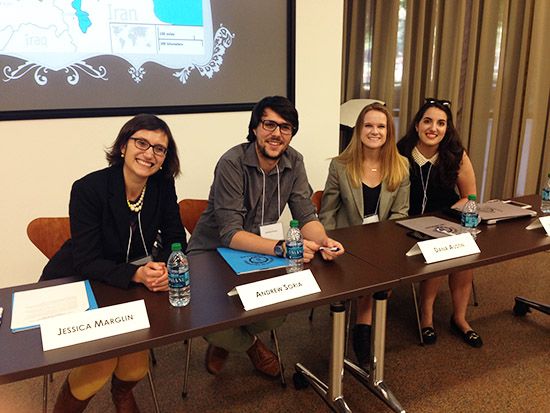USC Students Share Visual History Archive at ucLADINO Symposium

From left: Jessica Marglin, Andrew Soria, Dana Austin and Lara Sassounian at their ucLADINO panel
Aided by their exploration of the Visual History Archive, three students and a professor from USC presented a panel discussion at the fifth annual ucLADINO Symposium at UCLA March 2-3, 2015.
Professor Jessica Marglin, Ruth Ziegler Early Career Chair in Jewish Studies and Assistant Professor of Religion at USC, taught a course last semester called “Culture in Diaspora: The Jews of Spain,” with graduate student teaching assistant Andrew Soria. The covered the Jewish diaspora from Spain and Portugal and how Sephardic Jews maintained ties of culture, commerce, language and identity.
When it came time for the class to write their final papers, Marglin introduced them to the Visual History Archive as a possible primary source, and the class received a personal tutorial from Visual History Archive curator Crispin Brooks.
Soria, a PhD candidate in comparative literature who studies Sephardic Jewish culture, literature and the Ladino language, said he encouraged several students to utilize the Visual History Archive’s 80 testimonies that mention Ladino language or culture or are conducted in Ladino. It seemed like a fantastic resource that wasn’t getting much attention, he told them.
When he read the class’s papers, he was pleasantly surprised.
“You never know quite know how an undergraduate paper is going to turn out, but as I was reading them and grading them, there were a couple papers that really stood out to me, and they were using the Ladino testimonies,” Soria said.
A colleague of Soria’s had asked if he wanted to present something at the upcoming ucLADINO Syposium, which has drawn Ladino scholars and community members to UCLA for the past five years. Soria proposed a panel that would focus on the research papers of two students from the class, Dana Austin and Lara Sassounian, who both wrote about Ladino.
“I wanted to show people what were doing at USC to hopefully further Ladino studies, a very small and growing field, and say this is how the VHA can help researchers look at Ladino through a different perspective,” he said.
Austin’s paper focused on how the Holocaust impacted the decline of Ladino in Europe, and Sassounian’s discussed similarities between the loss of Ladino during the Holocaust and the decline of Western Armenian during the Armenian Genocide.
Soria said Austin and Sassounian were fantastic on the panel – only college sophomores, it was their first-ever presentation at an academic symposium. The audience was interested and affected by their research and many commented how much it meant to them to see the work the students had done.
“I think they were most impressed by the fact that Dana and Lara have no background in Sephardic or Ladino before the class and now they were presenting these papers,” Soria said. “I think that really touched them because a big concern for Ladino speakers is that Ladino might die. To see two non-Sephardim engaging with this material was I think a really emotionally charged experience for a lot of people involved.”
Since Ladino is spoken by so few people worldwide, research materials can be difficult to come by, Soria said. That’s why the Visual History Archive, with its dozens of video testimonies of Ladino speakers, is such a valuable resource.
“I was really trying to encourage the people who were there to get engaged with the Shoah Foundation whether they have testimonies themselves or want to look at them for their own research,” Soria said. “Hopefully something will come of this in terms of producing research for somebody to let people know this is out there.”